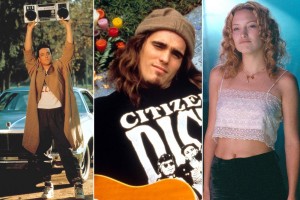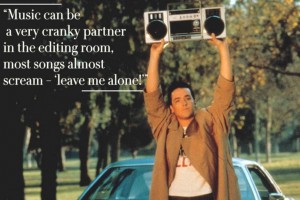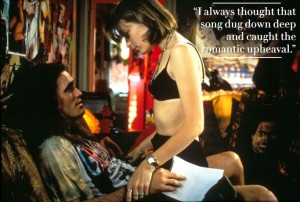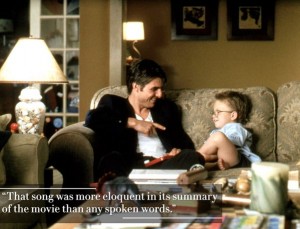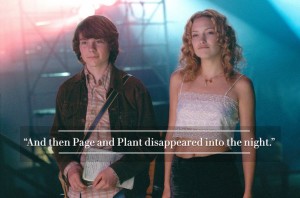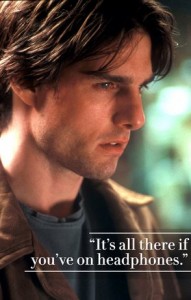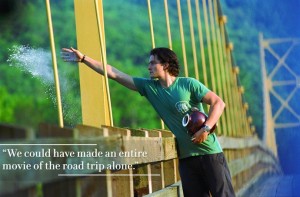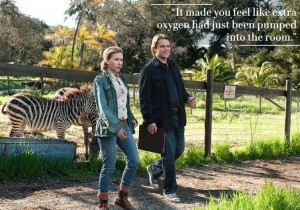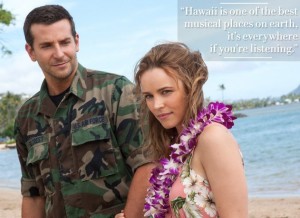Aloha – Vanity Fair
Cameron Crowe Takes Us on a Musical Tour Through His Filmography
After over 30 years as a writer and director in Hollywood, Cameron Crowe’sreputation precedes him. Though his films range a bit in time period, genre, and location, there are a few things you can rely on from a Crowe film. For one, his heroes are refreshingly earnest; this isn’t a filmmaker that dabbles in irony. For another, there will always, always be a killer soundtrack.
Cameron Crowe famously got his start as a teenager writing about music for Creem, Circus,and—as chronicled in the 2000 film Almost Famous—for Rolling Stone magazine. His intense love of music drips off the page of that teenage writing and bursts out of every frame in Almost Famous. It’s why the movie Singles—completed before the Seattle-grunge boom, thank you very much—became a perfect time capsule for the musical sound that defined a decade. It’s why, despite having only made eight feature films so far, Crowe is responsible for not one, but two of the most memorable movie musical moments of all time. You only have to see Lloyd Dobbler thrust that boom box over his head or watch the hungover members of Stillwater joyfully belting out Elton John to feel a newfound love for the power of lyric, bridge, and chorus.
In Almost Famous, Philip Seymour Hoffman as Crowe’s real-life mentor, Lester Bangs, tells his young protégé, “The only true currency in this bankrupt world is what you share with someone else when you’re uncool.” It’s this philosophy, seemingly, that has driven Crowe’s entire career. Despite his famous rock-star friends, collaborations with cool movie stars like Tom Cruise, and official Hollywood stamp of approval in the shape of a screenwriting Oscar, the shaggy, affable Crowe remains unapologetically uncool. In that way, every passing soundtrack feels like a mix your untrendy friend or family member would make for you. Crowe’s not trying to impress, but he is giving fresh takes on enduring classics and handpicking new, rare gems for us to love and treasure as much as he does.
In anticipation of his latest film, Aloha, we asked the director to take a look back at his body of work through the lens of the passion that started it all: music. Read on to find out why that famous boom-box scene originally had a much creepier vibe, what music Scarlett Johansson prefers to put on a mix, and what the original ending of Almost Famous was.
SAY ANYTHING… (1989)
VF Hollywood: You’ve said before that no song other than “In Your Eyes” would have worked for that famous boom-box scene. But Peter Gabriel’s song wasn’t a massive hit before Say Anything. What’s more rewarding as a filmmaker? Putting your stamp on a newer song, like “In Your Eyes,” or putting your stamp on a well-known song, like “Tiny Dancer?”
Cameron Crowe: Music can be a very cranky partner in the editing room. Most songs almost scream, “Leave me alone!” “In Your Eyes” and “Tiny Dancer” were both huge personal favorites of mine, so I took a lot of satisfaction in being able to compliment them in some way. Especially “Tiny Dancer.” I’d written the scene for that song . . . but that’s never a guarantee. Most times the song you really want to use will reject the hell out of you. I have a whole bunch of music I’ve been trying to use for years. One of those songs is My Morning Jacket’s “I Will Be There When You Die.” One day! In Aloha, we were finally able to use Josh Ritter’s “Come and Find Me.” We had a mini-celebration that night in the editing room.
The Peter Gabriel boom-box scene is obviously the moment of the film, but that’s not the song that was playing on set when Cusack shot it. Do you think the scene would have been any different if you had the actual song playing?
Absolutely. It was completely different with the song John Cusack was playing when we filmed. What he’s actually playing is Fishbone’s “Bonin’ in the Boneyard.” John was a big Fishbone fan and turned us all onto the band. But when we watched the scene as filmed, with that tune playing outside Diane Court’s window, the effect wasn’t particularly romantic or yearning. It was: “Hey girl, I love Fishbone and I’m not going to let you sleep.”
SINGLES (1992)
Paul Westerberg’s “Dyslexic Heart” became an anthem of this movie, and the soundtrack, required listening for fans of Seattle grunge. But is that the song you identify most with Singles?
I love “Dyslexic Heart,” particularly Westerberg’s acoustic demo that we just put on the expanded version of the soundtrack . . . for me, though, the song that best captures the movie is Pearl Jam’s “State of Love and Trust.” Eddie Vedder wrote the song after he’d read the script, and I always thought that song dug down deep and caught the romantic upheaval and fuck-the-world passion of a young relationship. The band still plays it live, and it always takes me back to the original feeling of the movie.
You’ve said before that you didn’t mean to make a film about Seattle grunge, but about relationships and your time in the city. Would you change the soundtrack in retrospect to get away from that, or is the music essential to understanding the relationships of the film?
Wouldn’t change a thing. The movie and the soundtrack are like snapshots of the city and the time and the feeling of promise in the air. I would put a few more songs on, and we finally did recently. Truly’s “Heart and Lungs” is one of the songs that belonged. That song should have made the starting team. Also, I would add more Alice in Chains. Hugely influential band, then and now.
The story goes that Nirvana was too expensive for the soundtrack by the time the studio finally got around to releasing Singles. Are there any other quintessentially grunge songs that got away here?
I don’t think it was a matter of expense. I think Nirvana didn’t want to be a part of it. They did originally. The band had blessed us using stuff from Bleach and they even sent us early mixes of Nevermind. But as the whole grunge thing exploded, and Pearl Jam and Nirvana famously slipped into opposing camps, it became less attractive to Nirvana. (Pearl Jam also appeared in the movie as actors.) Using Nirvana would have been overkill as well. Much more apropos was the inclusion of Mudhoney, and their take on the whole explosion [with] “Overblown.”
JERRY MAGUIRE (1996)
Can you talk about that quiet, non-quintessentially Bruce Springsteen song “Secret Garden” that plays throughout. Is that your favorite musical element of the film?
Yep, that’s my favorite musical moment in the film. I like when Cruise sings “Free Fallin’”too, but “Secret Garden” kind of claims my heart. I fell in love with “Secret Garden” as soon as I heard it on the greatest hits album. It felt so vibe-y and gorgeous and I played it while we filmed the scene. I remember still listening to the song, after we’d called “cut” on Renée Z.’s shot in the kitchen scene. She was standing there in that Audrey Hepburn dress, and the crew was breaking down the cameras and moving to the next scene, and we were still standing there listening to the song. Janusz Kaminski, the cinematographer, shouted, “Get over it, you two!” We were still in the “Secret Garden” spell. Amazingly, the song felt exactly the same way in the editing room. It never budged from that spot, and continues into the next scene in the street, where we were doing a little homage to My So-Called Life.
Aimee Mann wrote “Wise Up” for the film but it didn’t end up in the final version; though it did make it onto the soundtrack. Are there any other songs specifically written for your films that haven’t made the cut?
“Wise Up” is definitely the one that got away. When Aimee Mann first gave us the song, it was a simple piano demo and I used it for a smallish personal moment in the movie. Jerry was just moving through the airport. Aimee and Michael Penn then finished the song, beautifully, and it became something larger, more lush, more of a personal epic, and quite incredible . . . suddenly it was too big for the scene it was meant for. It was late in the game and all the other spots were taken. It was definitely heartbreaking to not be able to use it. Of course, Paul Thomas Anderson was smart enough to give it a bigger home in Magnolia. Of the other songs written for one of our movies, and painfully unused, the main one is probably the Smithereens’ “A Girl Like You,” which was written for Say Anything. Great song, but it explained the plot too much.
ALMOST FAMOUS (2000)
You weren’t able to get the rights to “Stairway to Heaven” for Almost Famous. (Though you found a creative way around that for the director’s cut.) Are there are any other songs you wanted here but weren’t able to track down?
No, thanks to the hard work of Danny Bramson, our music supervisor, we got everything else we asked for. Many of the bands gave us a break on the costs too, because they knew it was a labor of love. “Stairway to Heaven” was off the table because the band just didn’t want to touch it. That song, they felt, had ascended to some other place . . . it lived in its own world. But Jimmy Page did say to us, “Use one more song of ours, (‘Bron-Y-Aur-Stomp’), and we’ll give it to you for free.” That was definitely a miracle moment, and a great memory . . . as was a drink after their screening of the film with our editor Joe Hutshing and me. We talked about Jeff Buckley, quaaludes, the spirit of 1973, politics, and everything in-between, and then Page and Plant disappeared into the night. It was their one day of the year when they got together to discuss all their Zeppelin business. Besides that, the other big “get” was Neil Young approving an acoustic version of “Cortez the Killer” that I’d gotten from a bootleg. I think he went back and found another version from the subsequent night.
In reference to Almost Famous you said there were times in filmmaking where you decided to “throw that speech away, let the camera and the music tell the story.” Other than William’s deflowering, can you think of any speeches or dialogue you cut in this or any other film because a musical moment just worked better?
Yes, there was another scene that was meant to end Almost Famous . . . Frances McDormand’s character gathered the family together to play them a song of her own (to match what her son had done earlier), Neil Young’s live solo version of “On the Way Home.” In the end, we decided not to hear that song or her dialogue, and to let the sequence live in a montage as the Stillwater tour bus drives away to the sound of Led Zeppelin’s “Tangerine.” That song was more eloquent in its summary of the movie than any spoken words.
And then we listened to the Beach Boys song “Feel Flows,” which came next, over credits, and it was time to lock the movie. Done. Someone called me and said they were sitting near Brian Wilson in a theater when he saw the movie. As “Feel Flows” played, they heard him excitedly say, “That’s my brother’s song!” And then he began to cry, because he said it sounded so good to [hear] him again. Which for a Carl Wilson fan is pretty much all you want to hear. That’s always our dream, to program the movies like a radio station that can surprise you with esoterica, obscurities, or forgotten favorites. That whole movie was a love letter to the power of loving music, and what it is to be a fan.
VANILLA SKY (2001)
You’ve said the film was inspired by, but never used, Julie Miller’s song “By Way of Sorrow.” Are there other songs that people might be surprised influenced your films?
Julie Miller’s “By Way of Sorrow” is still there, every movie, trying to land. There would be no Vanilla Skywithout it. Same with “I Will Be There When You Die” by My Morning Jacket, the original inspiration for Elizabethtown. Joni Mitchell’s “Court and Spark” was the inspiration for the line, “You complete me,” in Jerry Maguire. So much of what I’ve done as a director comes directly from the feeling I’ve gotten from a piece of music or lyric. Or sometimes a sequence from another movie, like that beautifully flowing live performance of “Cucurrucucú paloma” in Almodóvar’s “Talk to Her” . . . which was a direct influence on Emma Stone’s playing “Waimanalo Blues” in Aloha.
In a soundtrack filled with dreamy futuristic sounds from bands like Radiohead, you chose the Rolling Stones and the Beach Boys to accompany David’s “tech support” meltdown. What about those classics fit this futuristic moment for you?
In many ways, Vanilla Sky was a mash-up movie about pop culture and the subliminal effect it has on all of us. When David Aames (Tom Cruise) purchases a virtual future, he requests indelible images he’d observed and longed for as a kid. The feeling of the perfect girl clinging to your arm on a cold afternoon . . . turns out he bought the experience he wanted when he first saw the cover of Bob Dylan’s The Freewheelin’ Bob Dylan. The whole pop maze we’d tried to create with the movie actually came full circle when I was introduced to Bob Dylan on the set of his movie Masked and Anonymous. He had seen Vanilla Sky in the theater and said, while watching it, “I suddenly felt like I’d been there before, and then I realized . . . I had.” So many of our movies are filled with little Easter eggs, many of them musical and some of them visual. The “tech support” meltdown and the murder of Cameron Diaz’s character Julie Gianni actually contains studio chatter from the recording of “Good Vibrations” when Brian Wilson realizes there was a fire nearby on a freeway. And there’s also a bit of Roger Waters melting down on stage after a fan keeps launching firecrackers. It’s all there if you’ve on headphones.
ELIZABETHTOWN (2005)
Singles, with all its grunge, and Elizabethtown, with southern artists like My Morning Jacket and Ryan Adams, seem to have soundtracks really grounded in a sense of place. Is Aloha, with its uke and slack guitar music, similar? How fun is that to go deep into the sound of a given place?
Absolutely true. It’s so much fun to immerse yourself in the musical mind-set of the place where your story is set. Sometimes you choose the setting BECAUSE of the music. Alohawas very much one of those instances. I’d always wanted to set a story in Hawaii, beginning in 2005, then came all the research that filled the movie with details. I got completely immersed in the work of the Hawaiian master Ledward Kaapana, who is now one of my favorite all-time guitarists. You can still see him playing in front of a tip jar, at the Kona Brewing Company on Oahu, most Sunday nights. Hawaii is one of the best musical places on earth, it’s everywhere if you’re listening. Their last ruler before the American takeover in 1893 was even a songwriter, Queen Liliʻuokalani, who wrote “Aloha ‘Oe.” Hawaii is all about music and that feeling, those wide-open chords and the appreciation of their land and spirit in song. It gets under your skin instantly. We wanted to capture that feeling in Aloha.
You cram nearly a dozen songs into that 10-minute road-trip sequence. Was there ever a version that had more music in it? Have you ever considered releasing a longer version of Claire’s road-trip mixtapes?
Now that’s a great idea! We could have made an entire movie of the road trip alone. Perhaps one day we’ll do that cut, there’s a few different ones of Elizabethtown. The movie’s been on TV a lot lately, and I’ve been hearing from people who are curious about the longer cut. It would be super great to do a full mix of Claire’s chosen songs . . . filled with stuff like Mark Kozelek and Joni Mitchell and Johnny Hartman and, of course, it would give us one more shot at using “I Will Be There When You Die”! Ha. We have so many hours of songs on Claire’s road-trip mix. She probably needs her own Sirius channel to get it all out there.
WE BOUGHT A ZOO (2011)
Even though it’s not one of your more music-focused films, you and Matt Damon have told the story of how you wooed him to this project with a musical mix you sent out with the script. Have you done that for other films? Did Bradley Cooper get a mix for Aloha?
Sure, everybody gets mixes. They also throw stuff back at me. Scarlett Johansson and Elle Fanning both did mixes for We Bought a Zoo that were crazy great. Both are singers and can really sling a mix your way. Elle leaned heavy into Florence and the Machine, Scarlett did a mix that went from Nick Cave to Tom Waits to early Stones and The Be Good Tanyas. For our upcoming show, Roadies, I played the actors their mixes live while they shot. That was fun. Rafe Spall and Imogen Poots are both Kate Bush fans. Kate’s music caused stuff to happen in the scenes that wouldn’t have happened without her music playing, urging the actors into deeper emotional waters.
There isn’t really a signature musical moment in this film but rather a low-key Jónsi soundtrack throughout. Was that a conscious move away from the song-packed Elizabethtown?
Yes, we are heavily influenced by Local Hero and how intoxicating and spare the score was. Jónsi did the opening cue the first day he arrived from Iceland. He just went into the other room with a very small almost-toy keyboard and played the melody. It was perfect, instantly. It made you feel like extra oxygen had just been pumped into the room. I remember saying “(a) we have our theme, and (b) you need to work with Wes Anderson too.” Wes ended up using the very same piece in one of his commercials.
ALOHA (2015)
What’s on the Aloha soundtrack now, that wouldn’t have been if the film had moved forward back in 2008?
“Factory Girl” by the Rolling Stones was always a part of that one, but some of the new pieces are David Crosby’s “Kids and Dogs” and Gil Scott-Heron’s “Whitey on the Moon,” and listen for something special at the very, very end of the credits. There’s also a sequence in the film when the Bill Murray character’s beloved satellite project, Brave Angel, goes haywire and a cavalcade of audio occurs . . . for that sequence we wove all kinds of stuff in there, the idea being that a true music or movie geek might have a blast identifying all the little scraps of audio whizzing around.
We’ve got a shot of Bradley Cooper rocking out and singing along to a song in his car in the Aloha trailer. Which song is that? It’s a scene you’ve used a couple times (John Mahoney in Say Anything, Tom Cruise in Jerry Maguire, the entire bus in Almost Famous). What about that particular singing-along-in-the-car kind of scene works so well for you?
Ha. That’s actually Bradley howling like a coyote. He’s a huge music fan, Metallica is his favorite actually, so he’s fully capable of singing . . . but he’s howling there. I do love people singing in their cars. More than a motif I think it’s a fascination. People are often more expressive singing alone in their cars than on their drunkest night singing karaoke.
In the preface to your favorite musical movie-moments list for Empire you said, “A great movie doesn’t need music to exist, and a wonderful song is already a perfect movie in your imagination. But sometimes the marriage works, and the result is an explosion, a memorable body rush that enhances both and rocks your soul along the way.” Are there any new filmmakers out there doing this particularly well? Or, better yet, what’s the last movie you saw that you felt pulled this off?
Great question. William Pohlad’s new film of Brian Wilson’s story, Love & Mercy, is a killer, a music-lover’s dream. David O. Russell is always great, from using Morphine in Spanking the Monkey, to re-inventing Steely Dan’s “Dirty Work” in American Hustle. I loved David Chase’s Not Fade Away—he used the Small Faces’ “Itchycoo Park” so well it’s ridiculous. And of course, it’s never too late to tip your hat to Whiplash.
Courtesy of Vanity Fair – Joanna Robinson – May 28, 2015


